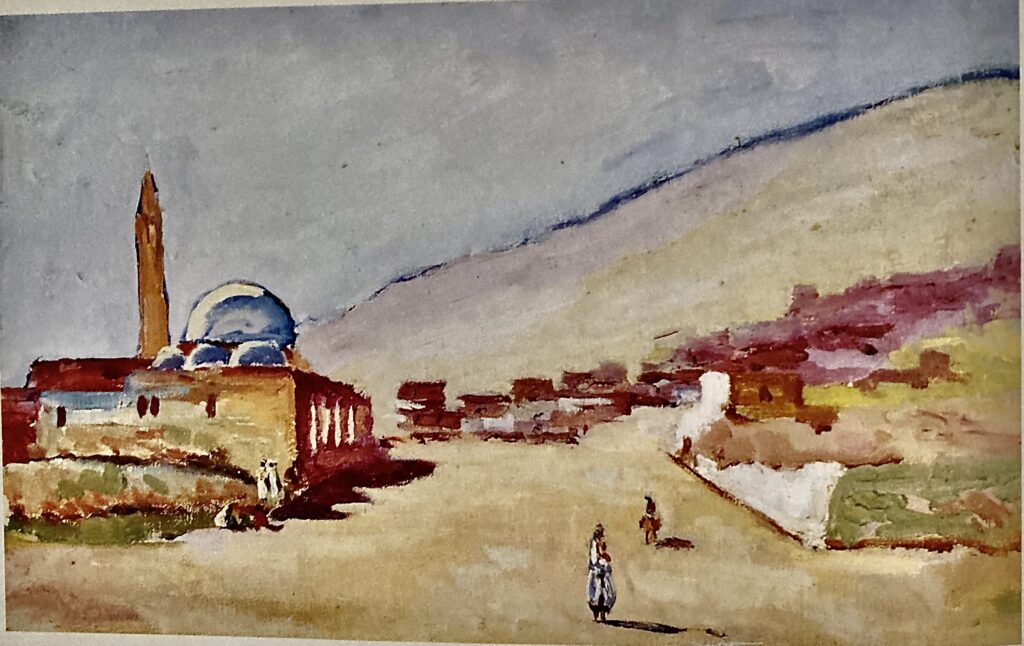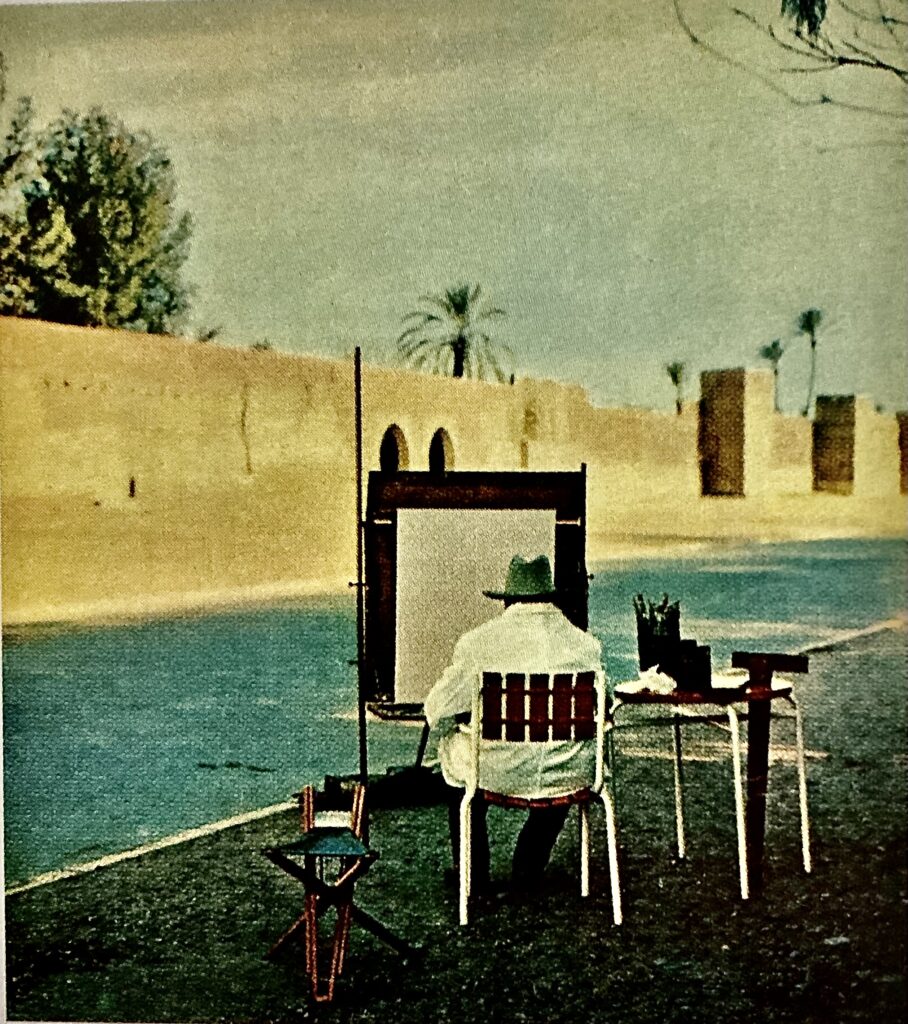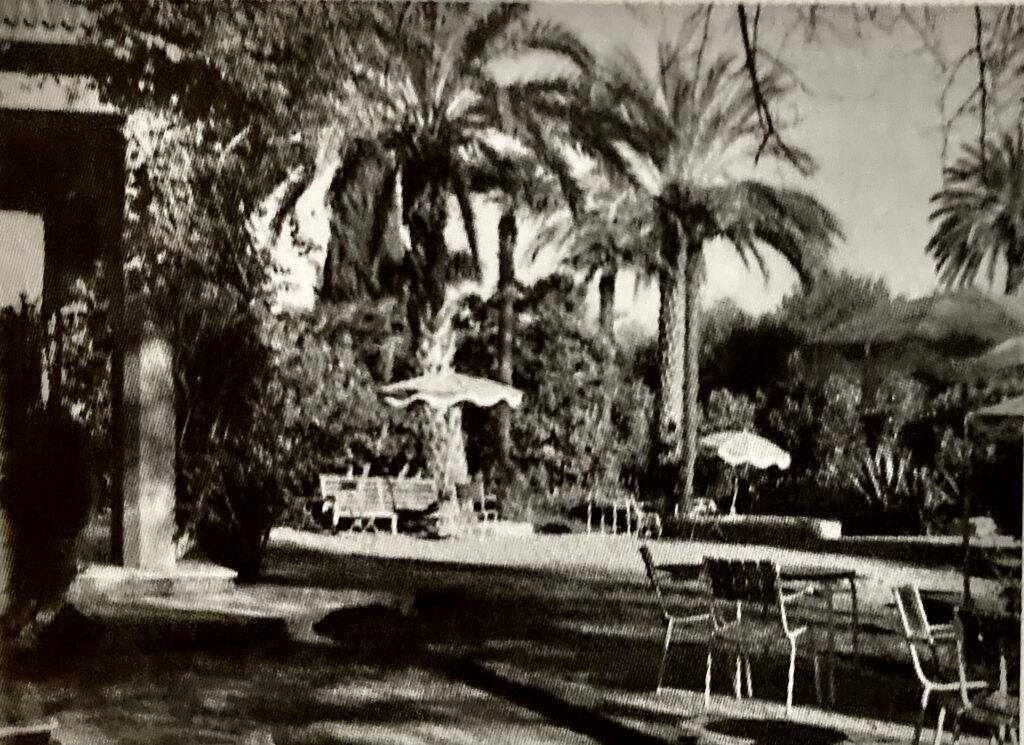
By Cheryl Anderson
“This is a wonderful place, and the hotel one of the best I have ever used. I have an excellent bedroom and bathroom, with a large balcony twelve feet deep, looking out on a truly remarkable panorama over the tops of orange trees and olives, and the houses and ramparts of the native Marrakech.”
Winston Churchill

“Sand dunes by the Pyramids near Cairo. painted about 1921.”
|
“At the Pyramids” |
View of Jerusalem, painted in 1921. |
|
View of Cairo from the Pyramids, painted in 1921. |
Pyramids in the distance near Cairo at sunset, painted in 1921 |
Churchill made a trip in 1921 to attend a conference about, “the dissolution of the end of the old Ottoman empire after the First World War, a conference was held in Cairo to discuss the political future of the Middle East.” Clementine accompanied Winston on this official trip to the Middle East. They landed at Alexandria and visited Aboukir Bay and continued on to Cairo. He rode a camel around the Sphinx, “and made several sketches at Sakkara.” It was then off to Jerusalem to paint, and to Tel Aviv. Churchill found time to capture images on canvas of Pyramids in the distance, sand dunes, and views of Cairo and Jerusalem.
|
“A little painting of Marrakech.” |

The valley of the Ourika. |
The quote, at the beginning of this article, is from the letter Winston wrote to, “My darling Clemmie”, on December 30, 1935 from the Mamounia Hotel in Marrakech. Churchill’s year began by failing to gain a government position in 1935. So, he took a holiday at Château de L’Horizon. Clementine and Winston then embarked on a working and painting holiday to Majorca via Barcelona. They returned to London, Churchill then left for North Africa where he could escape to warmer weather. This was his first “painting holiday” to North Africa. His friend, Sir John Lavery, and others had recommended the visit to the exotic location. Churchill wanted to explore painting possibilities. Tangier was his first stop, and from there traveled on to Marrakech. “He was clearly fascinated by Marrakech (the spelling he preferred) and its people and gathered a large number of photographs on this and subsequent visits, which still remain in the Studio archives at Chartwell.” The photos were used for accuracy of the local clothing and city gardens for his paintings.

A group pf palm trees corresponds directly to a photograph in the Studio archives at Chartwell. It was a gift from Churchill “to the Hudson’s Bay Company, in recognition of his appointment in 1956 as the first ‘Grand Seigneur of the Company of Adventures of England Trading Into Hudson Bay.'”
|
Palm trees in Marrakech corresponds directly to a photograph in the Studio archives at Chartwell. |
“A little painting of palm trees” corresponds directly to a photograph in the Studio archives at Chartwell. |

Painting of Marrakech given to Prime Minister David. They had both stayed at the Mamounia Hotel in 1936.
Churchill delighted in showing Roosevelt the sun setting on the Atlas Mountains after the Casablanca conference in 1943 saying to him, “You cannot come all this way to North Africa without seeing Marrakech…I must be with you when you see the sun set on the Atlas Mountains.” They stayed in the Villa Taylor, the house of the American Vice-Consul. Later in the year, after the Cairo conference, Churchill took Roosevelt to see the Sphinx and Pyramids. Winston was clearly drawn to such exotic sites, and the adventure. Expressing his enthusiasm for Marrakech, Churchill said to Roosevelt, “It is the most lovely spot in the whole world…Marrakech is simply the best place on earth to spend an afternoon.”
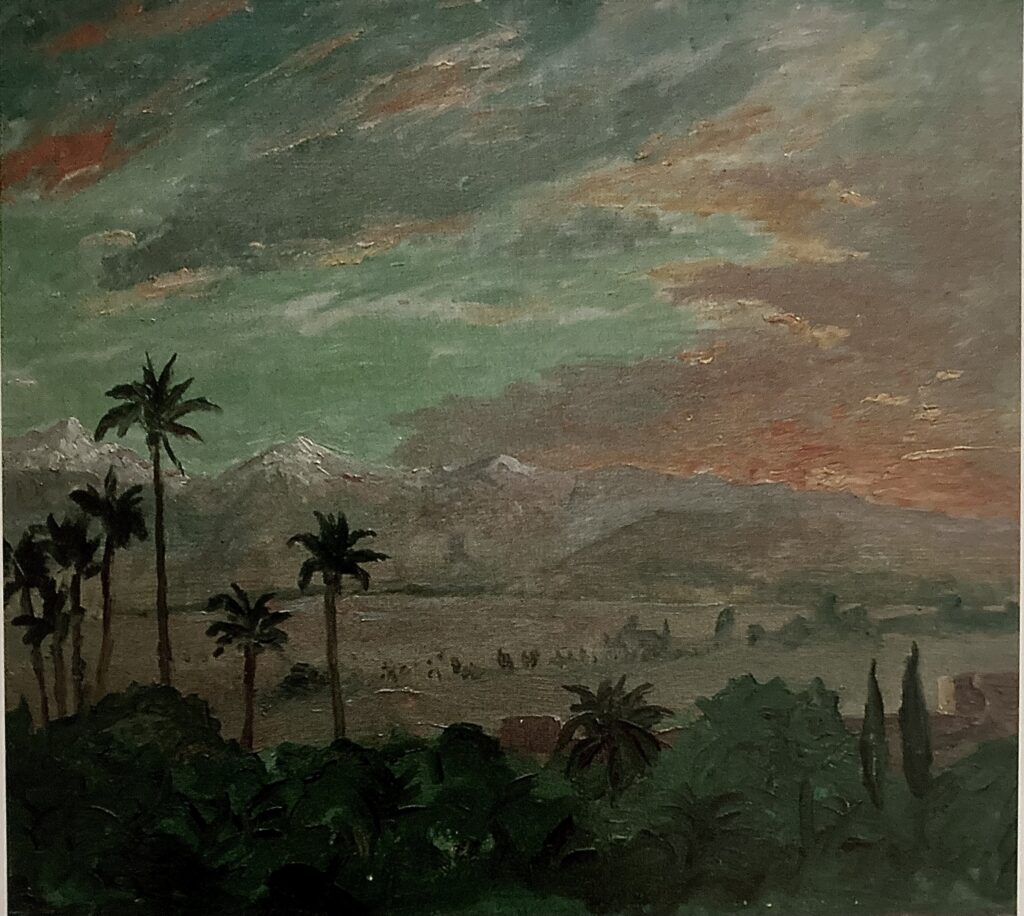
“Sunset over the Atlas Mountains.” This spectacular scene so attracted Churchill that he insisted on bringing President Roosevelt to witness it after the Casablanca Conference in 1943.”
|
A scene near Marrakech. Churchill gave it to Field Marshall Viscount Montgomery of Alamein. |
Entrance to the Gorge at Todhra, east of Marrakech. |
|
Near Marrakech |
In Marrakech |

The Ourika Valley with the Atlas Mountains in the background
Churchill returned to Marrakech in 1947. Once again, he stayed at the Mamounia Hotel. The warm climate, variety of subject matter, city, and desert scenes all beckoned him to return. “Within the city’s walls Churchill was clearly fascinated, for example, by its gardens, the great Mosque, and colorfully garbed people.” He painted from the balcony of the hotel, and at the Ourika gorge. It was a winter trip to paint and work on his war memoirs. He visited Marrakech regularly making six trips there between 1935-1959. Meryem Mikou states, “He used to go from balcony to balcony to watch for the light, as if to better capture the colors and reproduce them on his canvases.”
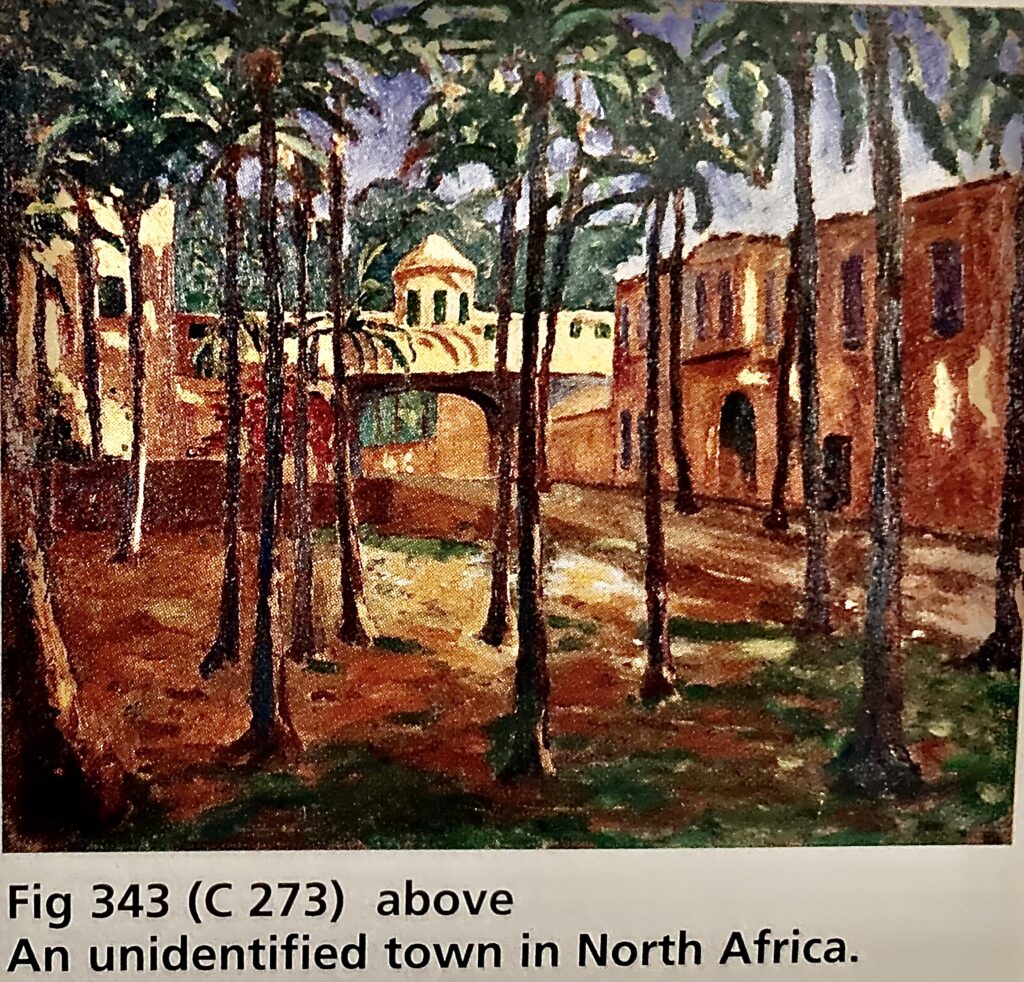 |
 |
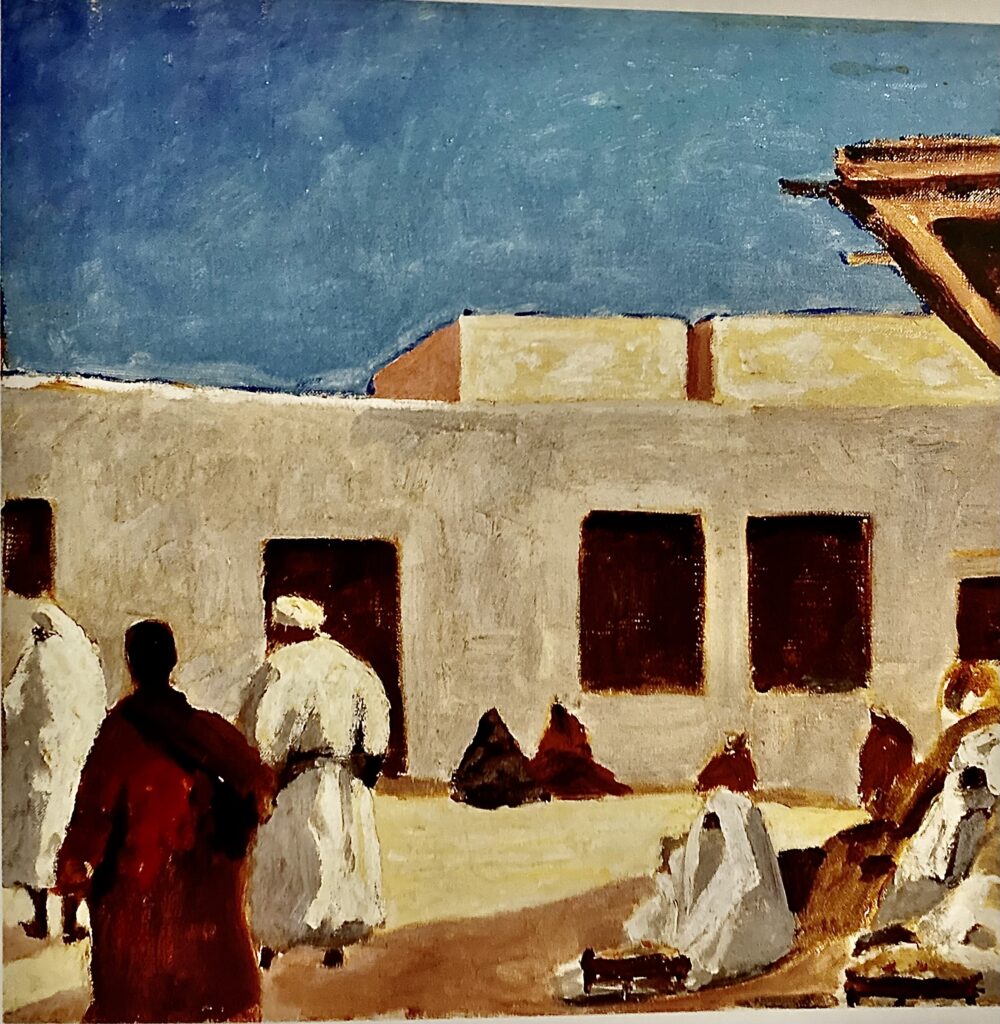
Marrakech scene. |
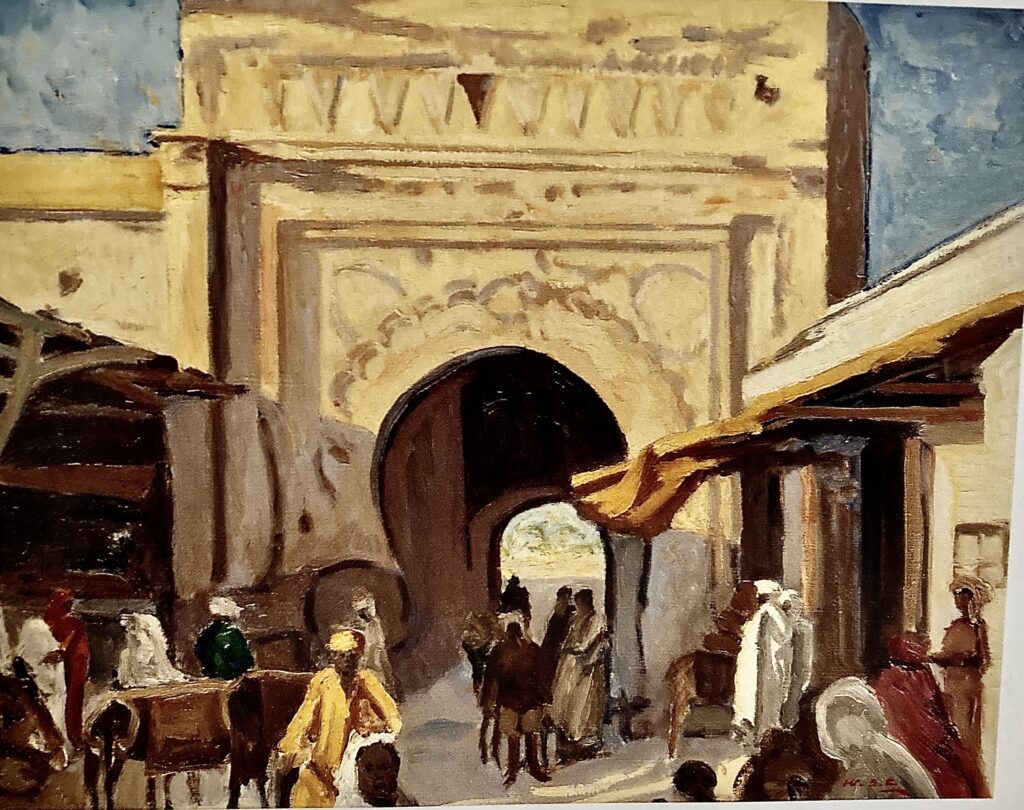
Scene in front of one of the gates in Marrakech. |

Marrakech that shows a garden within the walls, painted in 1947. The painting was given to his grandson Winston.
|
The valley of the Ourika. |
Marrakech |
“I am painting from the balcony, because although the native city is full of attractive spots, the crowds, the smells and the general discomfort for painting have repelled me.” Winston to Clementine December 30, 1935 from the Mamounia Hotel.
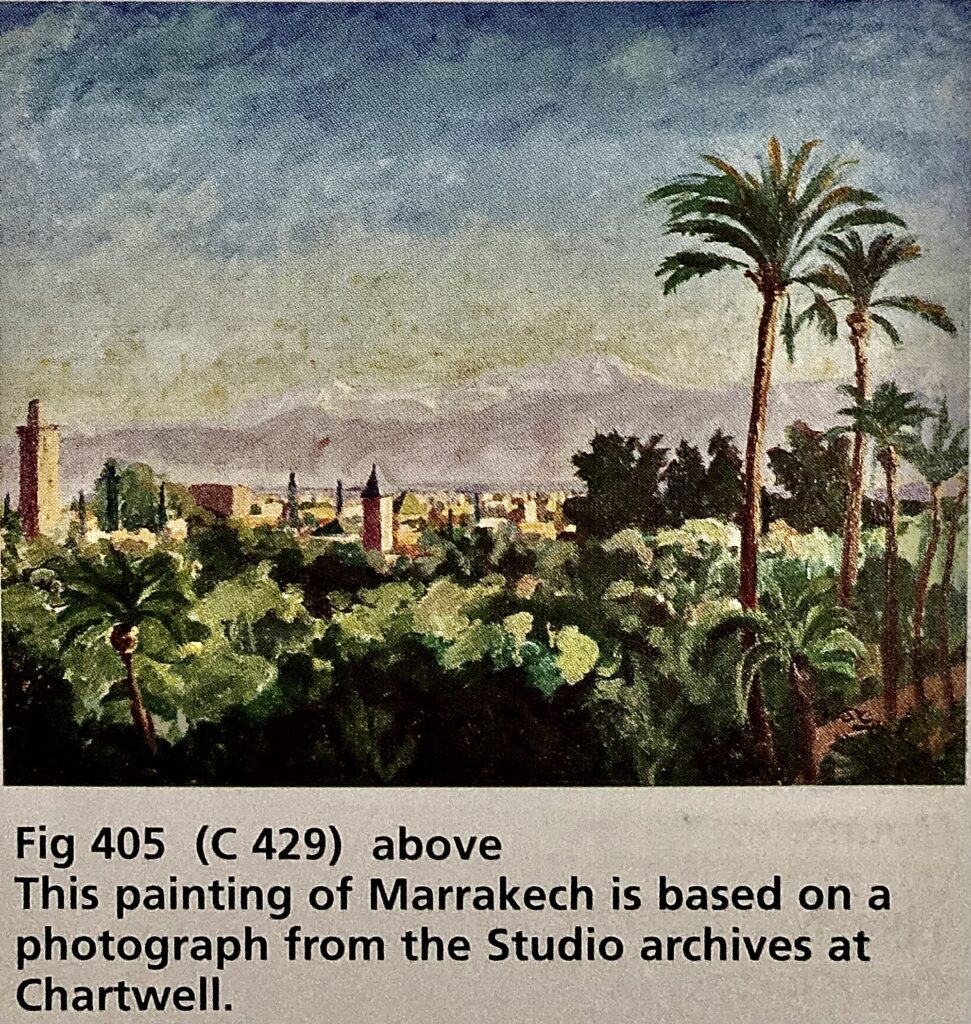 |
 |
|
A village near Marrakech. |
The Mosque at Marrakech. |
 |
 |
 |
.In 1950, Churchill discovered the delightful Tinerhir, in the Sahara desert located on the far side of the Atlas Mountains from Marrakech. As is evident in so many of his paintings, the Atlas Mountains were a special attraction. During the 1950 visit, artist Jacques Marjorelle, introduced him to tempera instead of oil, but although he was intrigued by the medium there are no known examples of him ever using it.

The Mosque at Marrakech.
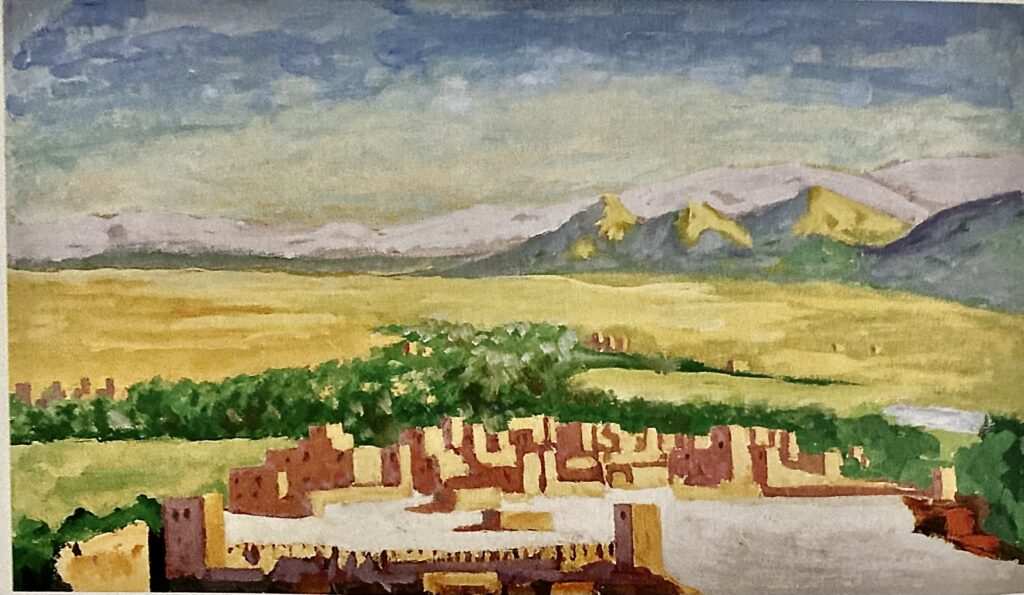
Marrakech

Palm trees near Marrakech. Based on on a photograph from the Studio archives at Chartwell. |

Group of palm trees near Marrakech. Based on a photograph from the Studio archives at Chartwell. |
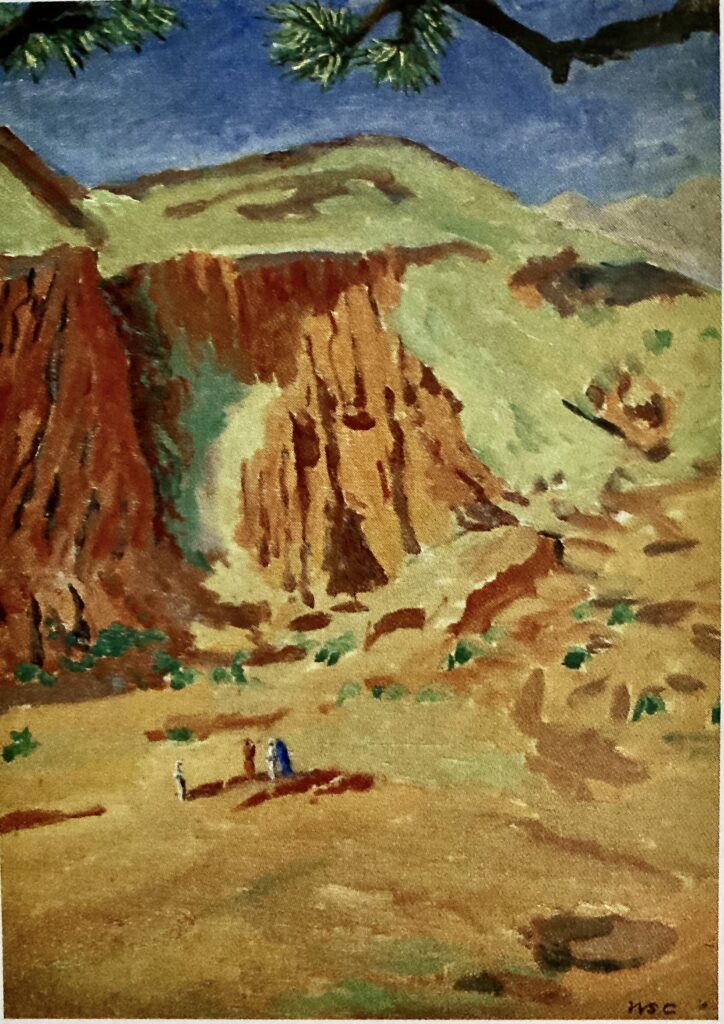 The Gorge at Todhra near Tinerhir. The Gorge at Todhra near Tinerhir. |

The Todhra Gorge based on photographs from the Studio archives at Chartwell.
|
In the 1930s, travel to Morocco became popular for the privileged few, but not yet for the masses. Some consider these early European visitors to be pioneers as it was not an easy journey, and it was an expensive one. Churchill can certainly be considered one of those pioneers. In his New Years Eve letter to Clementine in 1935, he wrote about the travel particulars, “But do not altogether exclude the idea of taking the boat at Marseilles. There are ten thousand ton steamers every week which in forty hours will take you to Casablanca, from which three and a half hours in a motor car brings you here. A étudier! ”
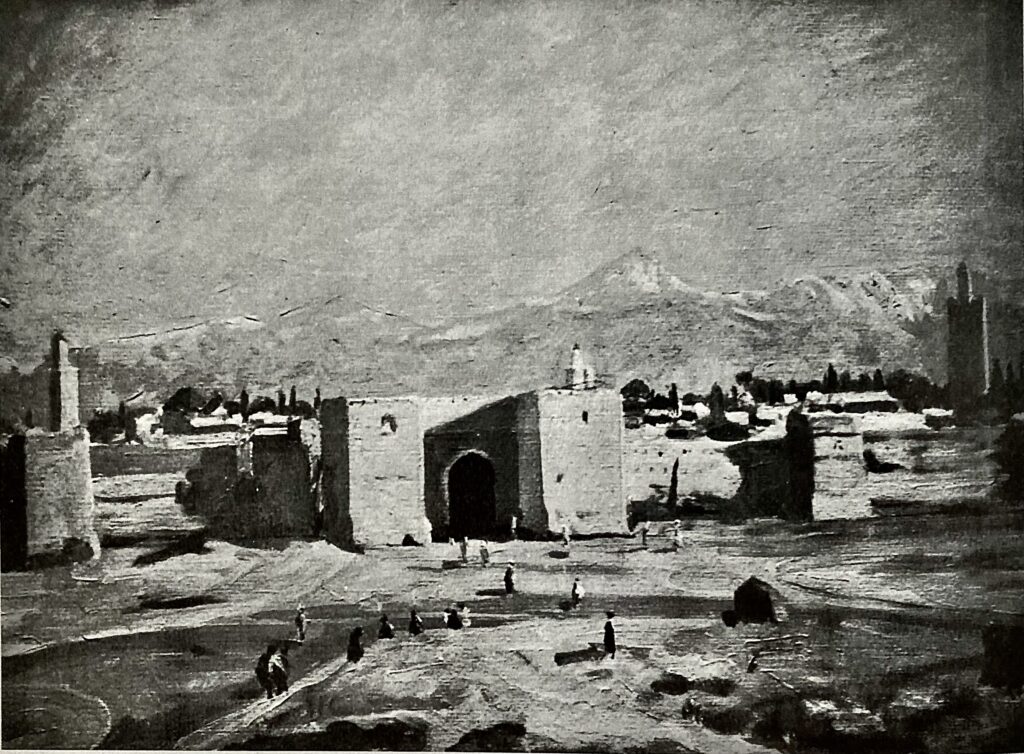
“Churchill gave this view of Marrakech to President Harry S. Truman.”

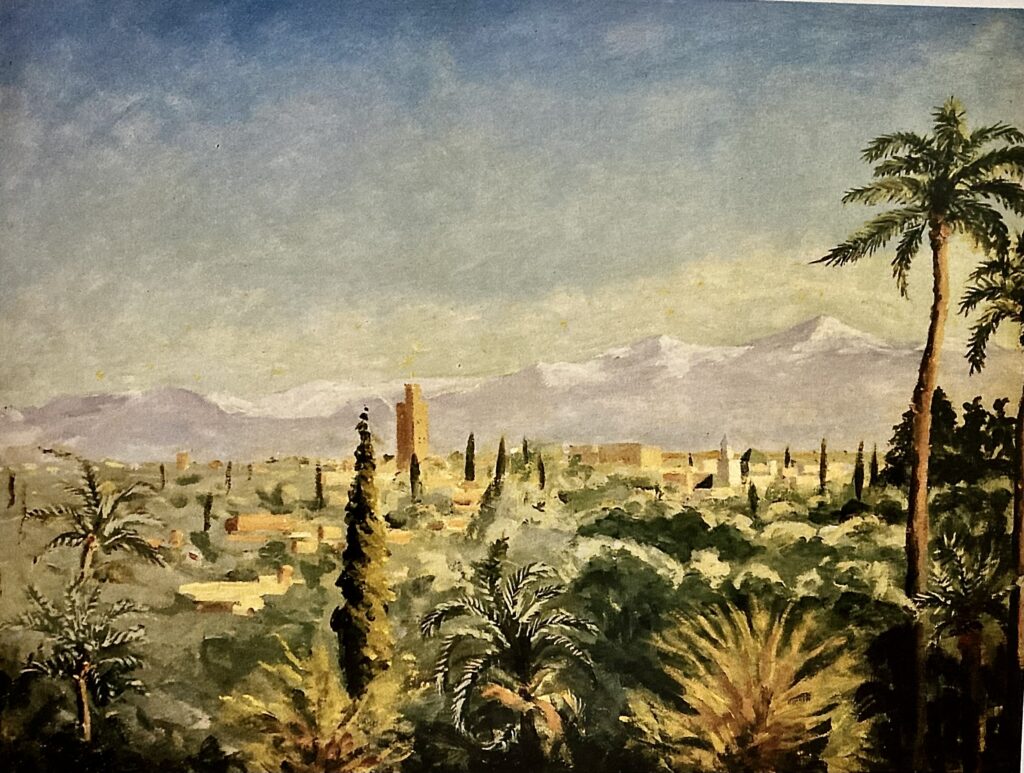
View of the Atlas Mountains. |

Valley of the Ourika based on a photograph from the Studio archives at Chartwell. |
Churchill painting at Marrakech in the 1950s.
The French devoted the 1920s to building the tourism infrastructure and promoted tourism to its colonies—at the time, Morocco was a French protectorate. The warmer climate was especially appealing to those living in the cold, gray, damp UK. By 1933, 36,600 tourists had disembarked in Casablanca compared to only 4,000 per year in the late 1920s. Churchill was pleased to find there were excellent French newspapers, impressed how modern and civilized was Morocco, calling Marrakech the “Paris of the Sahara.” Writing to Clementine that December 30, 1935, “You would be staggered by what the French have done out here…it is very pleasant to see what a vigorous civilized race can do in creating order and progress in these ancient deserts.”

A Marrakech gate thought to have been painted during Churchill’s last visits in the late 1950s.

Photograph from the Studio archives at Chartwell. The image of an Arab on a donkey was used in the painting in front of one of the Marrakech gates. Thought to have been painted during Churchill’s last visits in the late 1950s. |
A scene in Marrakech with the Arab on a donkey from the photograph. Thought to have been painted during Churchill’s last visits in the late 1950s. |
Winston Churchill was drawn to the colors, the natural beauty of it all, the Atlas Mountains, the light, and, of course, the agreeable climate. He described the mountains, of which he was fascinated, and surrounding terrain, to Clementine in 1935, “It is five hours to the ridge of the Atlas and they say you then look down over an immense area, first a great tropical valley, the another range of mountains, and beyond all the Sahara desert.”
|
Photograph of the gardens at the Mamounia Hotel from the Studio archives at Chartwell. |
“The walls at Marrakech. Painted in 1959 during Churchill’s last visit in his 85th year.” |
I’ll take you back to the Côte d’Azur in my next post about Winston Churchill as a painter! However, I couldn’t resit sharing his love of Marrakech. What I didn’t realize is that as early a 1921 he was fascinated with the desert scene, be it for conferences or painting holidays. His paint box and brushes were always part of his traveling gear.
“The garden at the Mamounia Hotel. This hotel is where Churchill invariably stayed from his first visits to Marrakech in the 1930s until his last in the 1950s.”
“Here, in these vast palm groves emerging from the desert, the traveler can be sure of eternal sunshine” and “contemplate with incessant satisfaction the majestic and snow-covered panorama of the Atlas mountains.” Winston Churchill
À bientôt
Quotes and Pictures:
Painting as a Pastime, by The Right Honourable Sir Winston Churchill, published in 1965 by Cornerstone Library, New York.
Winston Churchill-Painting on the French Riviera, by Paul Rafferty, published by Unicorn.
Sir Winston Churchill’s Life Through his Paintings, by David Coombs with Minnie Churchill, published by Gardners Books, 2003.
Churchill on the Riviera, by Nancy Smith, published by Biblio Publishing.
The Riviera Set, by Mary S. Lovell, published by Pegasus Books Ltd. 2018.
Churchill Defiant, by Barbara Leaming, published by Harper Perennial, 2010.
















